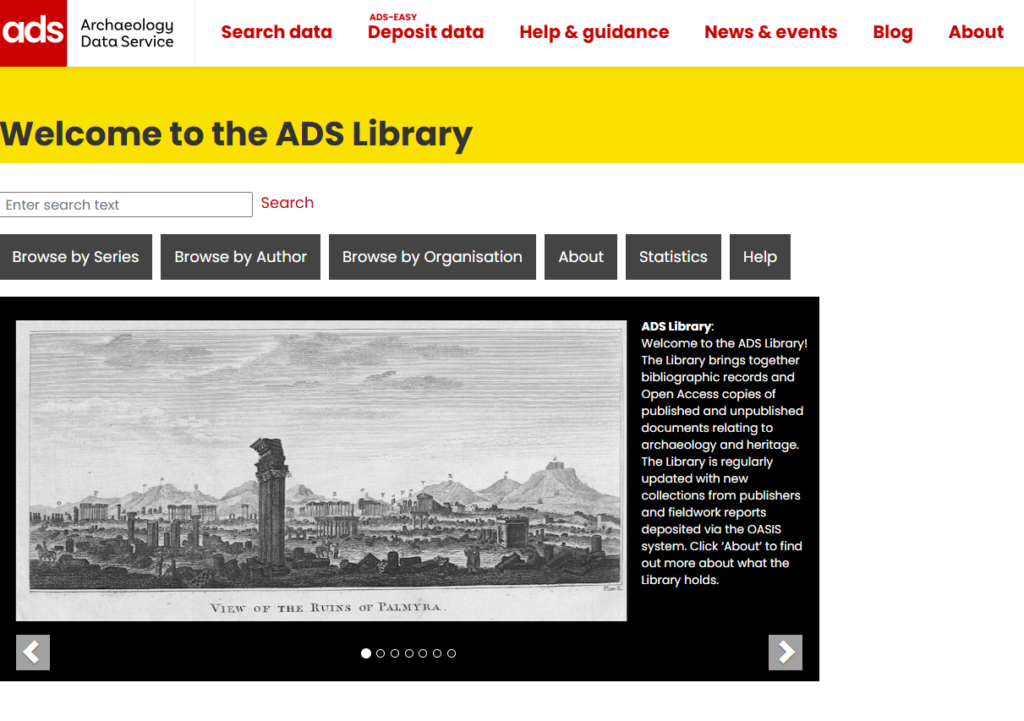Interfaces
When depositing with the ADS there are three main types of interface option available:
- Standard interface,
- Custom interface,
- Library interface.
Custom or ‘special’ interfaces provide depositors with more flexibility in how their data is disseminated.
Standard interfaces
All archives have the same initial layout:
- At the top of the page collection name, followed by creators and year of creation,
- A sidebar that includes page navigation, licence and copyright information, primary contact, and resource identifiers (including DOI),
- A introduction page,
- An optional overview page,
- A metadata page,
- A usage statistics page that shows the number of visits to the archive, file downloads, page views within the archive, and cumulative totals. These totals are shown on graphs that can be exported or printed.
The information utilised for these standard features (with the exception of the usage statistics) is specified by the depositor in the collection-level information provided to ADS.
Standard downloads
In a standard interface the downloads are organised by data type.

Examples of a standard downloads page:
- Digital Archive from Archaeological Works at Hornscroft Park, Bolsover, Derbyshire, January-February 2024
- Image and Vector Data from an Archaeological Evaluation at Blotts Barn, Brooks Road, Raunds, 2023
Custom interfaces
A custom interface can be requested for any data collection, however, they are often used for larger collections not deposited via ADS-easy and may have an impact upon the cost of a data deposit. To discus the cost for a custom interface please contact the ADS collections Team.
A custom interface includes all the layout features described above for the standard interface, but can differ in relation to the download page structure and the addition of special features such as data viewers, interactive maps and search queries.
Custom downloads
A custom interface usually differs from a standard interface in the structure of the downloads page. For larger archives a downloads page is organised by data type may not be suitable as the number of files for each data type can run into the thousands. A common customisation is to disseminate data based on the datasets original data structure. Requests for custom download pages based on a data structure of no more than two levels can be facilitated at no extra charge, however, more complex structures can be accommodated for an appropriate additional charge.

Examples of custom download pages:
- British Institute in Eastern Africa Digital Archives: Aksum
- Digital Archive from Sabratha Excavations: The Kathleen Kenyon and John Ward-Perkins Collection, 1948-1951
- Data from the Gatehouse Community Archaeology Project at Pontefract Castle, Pontefract, West Yorkshire, 2019-2020
Data viewers
A 3D Heritage Online Presenter (3DHOP) for 3D models or RTI data can be included in the downloads pages of suitable data collections at the request of the depositor. This will incur a small additional charge per viewer for the addition work required to implement 3D HOP in the interface and to convert the data into the format required by 3D HOP.
Examples of data viewers:
- Data from an Archaeological Building Survey at Barn Cottage, Drayton Bassett, Lichfield, Staffordshire, 2020 (HS2 Phase One)
- Data from a Building Survey at Capitol Joinery Timber Yard, Coleshill, Warwickshire, 2019-2023 (HS2 Phase One)
Search queries
For some datasets the addition of an online search interface can significantly increase the reuse value of a dataset, allowing users to directly interact with your data within a web interface. A search query form can be as simple or as complex as required, however, we can only build searches that are possible within the data that is provided to us. The inclusion of a search interface will always incur an additional charge based on the time required to build the search query and the day rate of the appropriate ADS staff member.
Examples of search queries
- British Institute in Eastern Africa Digital Archive
- A14 Cambridge to Huntingdon, Cambridgeshire Improvement Scheme: Digital Archive for Archaeological Works
- Torksey Viking Camp: Illustrated Artefact Catalogue, 2024
Maps
Like search queries an interactive map can add a great deal of additional reuse value to a dataset. The ADS can add an interactive map to a data collection if the data collection includes suitable spatial data. Maps can be as complex or as simple as required but will always incur an additional charge based on the time required to build the map and the day rate of the appropriate ADS staff member.
Examples of interactive maps:
- WallCAP: The Hadrian’s Wall Community Archaeology Project Collections and Map
- Data from an Archaeological Recording at Wendover Green Tunnel, Wendover, Buckinghamshire, 2020-2022 (HS2 Phase One)
Library interface
Library collections such as journals, monograph series and collections of reports differ from a normal data collections. These collections are usually made up of a single data type and the discovery metadata is primarily bibliographic. Library collections are of most value when searched alongside other bibliographic records. Therefore, Library collections are provided with their own standardised interface viewable in the Library, which is included as standard in the deposit costs for all Library collections. The standardised Library interface includes a landing page that allows you to Browse the collection, a Details page which provides information on the collection, a usage Statistics page and a Search facility to search within the collection. Library interfaces cannot be customised.




